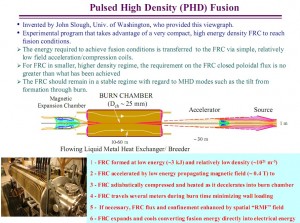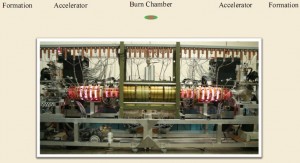May
7
A New Fusion Competitor
May 7, 2009 | 3 Comments
Last week saw Helion Energy enter the public domain with some proved up technology. The project looks like a spin-off from prior work by John Slough at the University of Washington. Some think in the forums about the field that there is potential here.

Helion’s technology in the greatly simplified form is about fusion from collisions of fuel at high speed to drive the fuel together so hard that they fuse so releasing the energy. It’s another one of the velocity for input energy designs that Bussard is famous for doing with inertial confinement as a targeting and fuel control system.
Helion simply looks to be sending fuel down two paths directly at each other so making collisions probable. The technology is being called Field Reversed Configuration (FRC) that provides the fuel restraint into the directed path, which is a simple elongated current ring confined in a modest field from solenoidal magnets. It seems to be a form of two opposed rail guns shooting fuel directly at the other.
The rail gun technique is being said to currently achieve over 1 million mph from the opposing directions. When impacting the fuel has reached 25 million degrees C in the 1/3 scale reactor that Helion has or has access to.
In the middle of all this is the point of collision or the burn chamber where the fusion takes place and the energy released. The available drawings from prior work show the structure to be a bottle shaped magnetic confinement device. No information seems to be available for collecting the high-energy electrons and/or the heat and generating power. But that matter is thought to be an engineering exercise with solvable issues. Time will tell. All of the proposed fusion devices that work are going to be throwing off rather large amounts of high-energy electricity, so the matter has been given considerable thought.
The business end of Helion Energy is just as vague, well, actually more so than the technology. Many sense that this technology has a good shot at getting to breakeven and beyond so the business end needs serious consideration. Today the business, formed just this year, is an exclusive licensee from what many believe is the work of by John Slough at the University of Washington. The leader is President Philip Wallace who is busy seeking $20 million in financing to build a full-scale fusion engine. The question is can the concept get attention in the current economic conditions such that the program can continue on.
The puzzle for tech writers is the confusion about the fusor’s output. Will it be high-energy electrons or simply heat for making steam? At this date, having waited nearly a week for clarity, the answer could be one or the other and in the cursory view, both. It’s not a question that is being addressed. In fairness though, the effort isn’t about telling all of us about the fine details, it’s about raising the next stage of funding, so the development can continue. Sure, we’re dyin’ to know, but these folks have much more pressing matters to address.
There are interesting projections out to keep our interest peaked. The progress timing is quite fast by the usual fusion standards. If funding can be secured quickly the next step, the full-scale device could be testing and experimented with as early as 2011. This design can’t meltdown or runaway and offers no radioactive fuel waste. Fuel costs are dirt-cheap. Compared to coal the main fuel deuterium, could be 0.0004 the expense of coal.
Helion is planning to double up the fuel speeds to 2 million mph, and double or better the burn temperature to more than 50 million degrees C. Then Helion needs to work out a method for repetitive pulsing to load fuel for continuous operation such that commercial levels of energy will be produced. Then there is the energy extraction matter.
Having a full-scale unit will offer the conditions for optimization to higher efficiency. That plus a running unit will set actual conditions for working out the engineering matters.
Helion states that they have data available for scaling to commercial sized devices. They also claim they have the current device doing fusion now in the same technology as the full-scale proposal. The Helion design’s advantages center on not needing such complex devices as the ITER tokamak or the National Ignition Facility’s giant laser array. The velocity technique also doesn’t need the huge materials, complex design and tens of billions of dollars that compression and high temperature designs require. Its also quite small, a great advantage for installing into or near existing power plants.
Simplicity offers other advantages. Simple is more reliable, speeds up adoption and market acceptance, construction and training operators. If it works, it would sure be an electrical power generation boom. And carbon free to boot, missing the concern for price increases due to Cap and Trade schemes, unless the greedy hand decides to tax new technology some other way.
While still full of skepticism here, there remains the hopes for success in getting funding. Its way too soon to choose the fusion winners, so choosing all of them is the smart move. Even at $20 million, which on a personal level is a lot of money, that sum in view of an ITER budget item is barely consequential. Or in the total electrical power generation market of trillions, a very small research an development investment. If it becomes commercial, it would be a stunning smart investment move.
Comments
3 Comments so far




There are going to be some really p#ssed off people at ITER in France – if this interrupts their gravey train. They were going to sit around burning money for 50 years and then say, ‘Oops. It doesn’t work.’
[…] bookmarks tagged vague A New Fusion Competitor saved by 16 others MewMewIchigogirl bookmarked on 05/08/09 | […]
This may be the correct blog for anybody who wants to find out about this subject. You recognize so much its just about tough to argue with you (not that I in fact would want?-HaHa). You definitely put a new spin on a topic thats been written about for years. Terrific stuff, just wonderful!